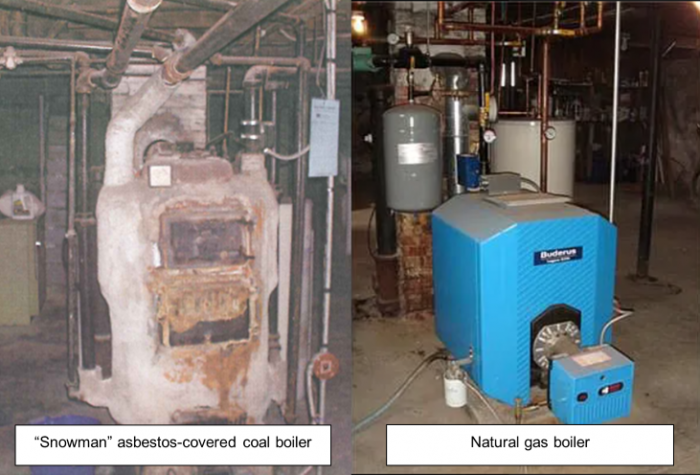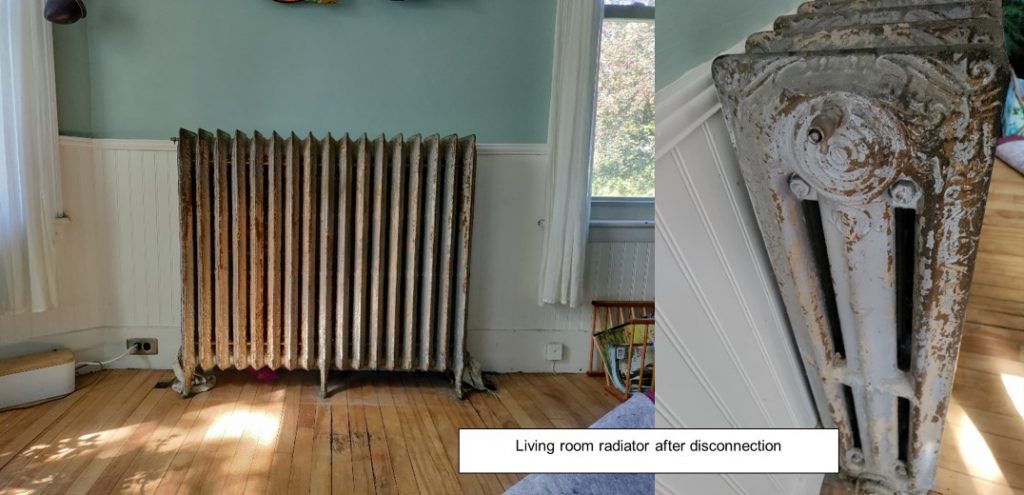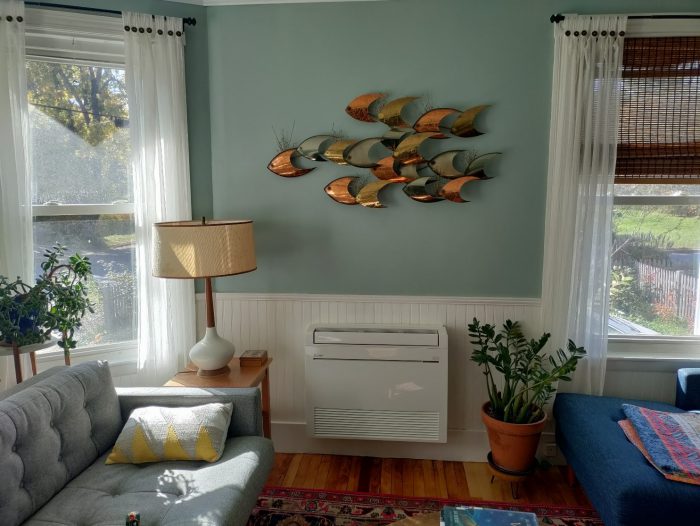Camryn Hansen, Zondits guest, 7/25/2023
After years of considering heat pumps and hearing from a series of contractors that my house was not a good candidate, I took the plunge and installed them anyway. I’ve now lived with my heat pumps for a full year, and here’s the rundown.
I live in Portland, Maine in an old house built in 1921. My house has been through a shocking transformation in heating systems. The last owner removed a coal-burning boiler covered in asbestos known as a “snowman” (and abated the area around it) before installing a German-made oil boiler. Both systems work by heating hot water that gets circulated through radiators throughout the house. When I bought the house, I converted the oil boiler to a natural gas boiler by changing out the burner and combustion controls (the little box on the front of the boiler) and signing up for natural gas service. This allowed me to remove the giant oil tank in my basement, which opened a lot more space. But the essential hot water radiator system remained the same.

A family with 10 children once lived in my house of fewer than 1,600 square feet (and shared a single bathroom). A house of this size shouldn’t have five bedrooms, but somehow it does—and they’re tiny. This configuration of tons of tiny rooms is what made the house less than ideal for a heat pump installation. Heat pumps work as both air conditioners and heaters, depending on seasonal conditions and the setting you choose. While they’re relatively good at moving warm or cool air through large spaces, it’s much harder to circulate air around doors and into the recesses of bedrooms.
And yet. The house didn’t have air conditioning, and in the height of the summer, which as we know, has been getting hotter and hotter, we’d been carrying heavy window ACs up from the basement and plugging them into extension cords, despite warnings to the contrary (not enough outlets in this old house). We wanted to stop. We also have a whole roof full of solar panels, so it made financial and environmental sense to take advantage of the solar energy to heat and cool the house.
So I called a heat pump installer who’d gotten a lot of good reviews on the NextDoor app. They came out and decided we could put in three indoor units that would all be connected to one outdoor condenser. This is commonly known as a split system. We had a choice of indoor units that mount on the ceiling or the floor. We chose to remove a couple of radiators and install the heat pump fan coils in their place on the floor.
It gets complicated
For those who aren’t aggressively DIY, removing even two radiators is no easy business. For our situation, the steps were as follows.
- A plumber had to come over and disconnect the radiators from the rest of the hot water distribution system, which required sawing through some pipes. We had to time this carefully because we couldn’t heat the rooms the radiators were in once they were disconnected…so we chose late May when it probably wouldn’t be getting super cold at night anymore.

- The plumber would not take the old radiators. We tried to find a buyer for them, but no one was biting. So we had to contact a junk service to haul them away before the heat pump installers arrived.
- The heat pump installers initially gave me an August install date but called in late May to say they could do it in early June instead. Luckily the plumber had just disconnected the radiators, but we had to hustle to get them hauled away before the installation date.
- My existing circuit breaker panel did not have the capacity for the added load from the heat pumps, so the heat pump installers had to upgrade my electrical panel in addition to putting in the heat pumps. This added a not insignificant amount to the installation costs.
- The radiators had been in the same spot for decades, possibly a century. There were holes in the hardwood floors and water damage around the holes. This meant that someone had to come and repair the floors.

- We looked around for a floor person and finally found one. He came over and said he could fix them, but for not that much more money he could fix them AND refinish the entire living room floor. Our floor was a wreck anyway, so we agreed to the full refinishing.
- That entailed moving everything out of our living room and sleeping somewhere else with the kids for 2 nights to let the finish dry and avoid the fumes.
- The refinishing job left all the baseboards stripped of paint, so we had to go in and repaint them before moving everything back in.
Now that all that work is done, the heat pumps are a delight. They’re virtually silent, comfortable in all but the coldest temperatures (I kept my natural gas service on for the winter to supplement the house’s heating in sub-zero temperatures), and attractive in the space. But it took A LOT of time, effort, money, and especially MOTIVATION to get here. For old houses like mine that need significant prep work to install heat pumps, the call to “electrify your home” for the sake of decarbonization is asking more of people than it feels reasonable to ask—certainly in the self-directed/self-managed way I went about it.
This got me thinking about what kind of support could help make a difference for people considering heat pumps but feeling overwhelmed by the scope of associated tasks. What could help people facing financial and logistical challenges, and what forms of social and informational support would help people make the right decisions? Look to future blogs where I explore the question of support in more depth.
Read the July 21, 2023 press release about heat pumps in Maine: After Maine Surpasses 100,000 Heat Pump Goal Two Years Ahead of Schedule, Governor Mills Sets New, Ambitious Target | Office of Governor Janet T. Mills

